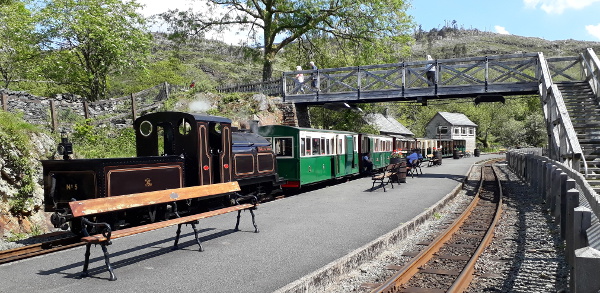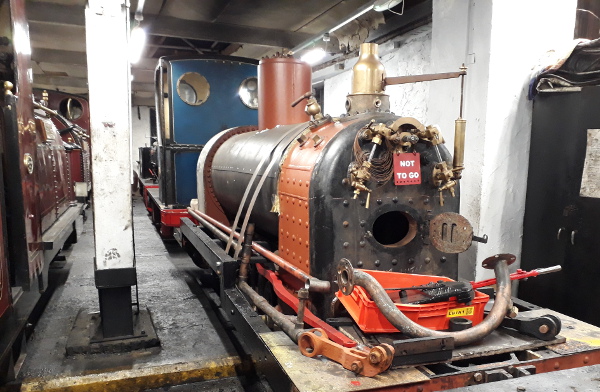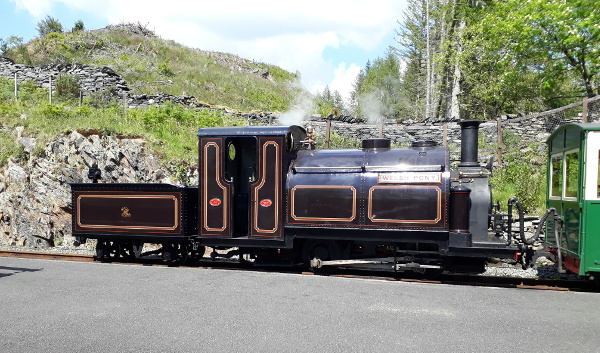On emotional lines
Or, a special locomotive
In the last post I mentioned I’d been up to North West Wales recently, for the first time since January 2020. The first place we headed to, naturally, was the Ffestiniog Railway, and it was bustling with activity: five engines in steam, I think (plus one diesel), several trains shuttling up and down the line. I couldn’t stop taking photos, either on the phone or on the Proper Camera, of every train I saw. And one in particular was special.

This is Welsh Pony, or Merlen Cymraeg, the one engine I was really hoping to see. “It’s Welsh Pony!” I said excitedly, snapping away, sending out photos and so on.
“What’s … so exciting about another train?” came back the replies.
“It’s Welsh Pony!”
Which obviously didn’t exactly cut it as an explanation. “I’ll try to explain more,” I said, “when I’m back at my computer and have time to put it into words. This is a very special engine for my generation of nerds.”
Welsh Pony was built back in the mid-1860s, one of a pair of very similar locomotives built for the Ffestiniog Railway by George England & Co of New Cross, following on from four slightly smaller side tank engines. Three of the earlier engines—Princess, Prince and Palmerston—were rebuilt to be rather more like Welsh Pony and its sister Little Giant, and those five together shared many decades of service.

The Ffestiniog’s fortunes started to decline from the First World War onwards. Little Giant was dismantled for spares in 1929, but as the 1930s progressed the railway struggled to fund necessary repairs on the ancient locos. Prince was out of use from 1936, and Palmerston from 1937. Welsh Pony was probably last used in 1940. When the railway closed to traffic in 1946, Princess was the only George England loco still running on the railway.

When the railway closed to traffic, the company didn’t shut down. It became the empire of one depressed, gloomy old man, who had worked for the line since he was a boy and had slowly seen it decay and rot away. He didn’t make any effort to save the locos, or the rolling stock, to cover them over or wrap them up or shut them away securely. They stayed where they had been left, many of them outdoors, some like Welsh Pony indoors, all close by the salt-spray of Harlech Bay. They rusted quickly, as the grass grew up around them. When a group of enthusiasts gained control of the railway after about eight years of closure, nothing was close to serviceable, and the enthusiasts had to carefully piece things back together on the tiny amount of cash they had to spare, repairing the most repairable locos and carriages one-by-one until they had the minimum they needed to offer a service. Welsh Pony, abandoned for about fifteen years when the railway reopened, was not one of them.

Welsh Pony hung around the railway, parked on various sidings, stored in various sheds. In the mid-1980s it was painted up and put up on a plinth, as Porthmadog Harbour Station’s “gate guardian” loco. It stayed on the plinth, rusting away in the sea air, until the early 21st century when it went back into storage once more. In 2014, restoration work on Welsh Pony finally started. A careful survey discovered that a huge proportion of the surviving fabric was just too rusted, and would have to be replaced. A new boiler was needed, new frames, new cylinders, new rods, but the wheels and valve gear are still original.

The new Welsh Pony’s fire was lit for the first time in June 2020, with the ceremonial event livestreamed to an audience of thousands. Before restoration the boiler had been lagged with wood, and some of the rotting lagging had survived all those years the engine was out of use. When the loco was dismantled some of it was set aside, and was used to light the first fire, another little piece of continuity.
But why is Welsh Pony so special? Why, when I saw it in steam for the first time was I quite so overwhelmed? Well, I guess, for those of us who grew up in the 80s and 90s, Welsh Pony was a fixture, the engine standing mute and silent at the entrance to the car park, a symbol of the railway and yet at the same time something cold, dead and filled with the past. There are many people of my generation who can remember climbing up the plinth and onto the engine, even though you probably weren’t supposed to. It seemed impossible to imagine the rusting machine would ever run again. Even when it was taken down from the plinth and cosmetically restored, tucked back away in a storage shed, it seemed impossible to imagine it would ever run again. To watch it being warmed up, from afar, on a cold morning about a year ago, was a sight we thought might never happen. To see it running, hauling a train again, to be able to see it warm, moving and alive, for personally the first time, felt like an impossible moment.

I’m not sure setting out the bald facts like this will help you understand what made me so emotional about it, to be honest. Maybe, along with everything else, it’s a bit of an insight into how my mind works. Hopefully, though, it makes some sort of sense even if you’re never going to have that feeling about the engine—about any railway engine—yourself. All I can try to do, after all, is explain.

 Home
Home